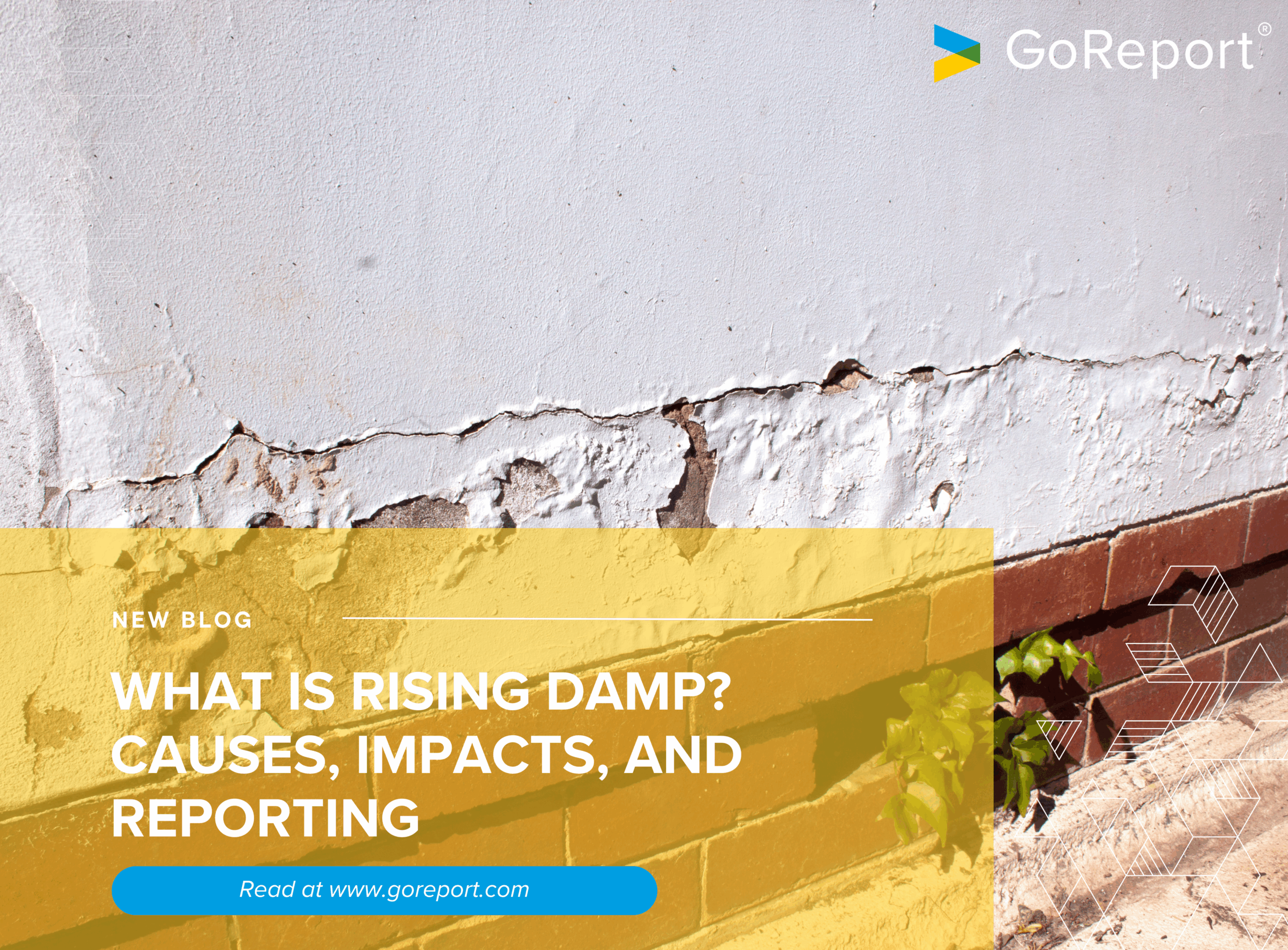What is Rising Damp? Causes, Impacts, and Reporting

If you’ve ever stepped into a room and caught that musty tang in the air, damp floorboards, salt-tide stains creeping up a wall, maybe even crumbling plaster, you’ve likely encountered rising damp. And for residential surveyors, the question isn’t just “what is rising damp?” but how to spot it, explain it, and report on it accurately and efficiently.
Because here’s the thing: rising damp doesn’t just knock a wall or two out of shape. Left unchecked, it eats into a property’s structure, its value, and, frankly, your client’s trust. So whether you’re inspecting a two-up-two-down in Leeds or a stone-built cottage in Sligo, knowing how to identify and document rising damp properly is part of what sets a professional surveyor apart.
Contents
- What Is Rising Damp?
- What Causes Rising Damp?
- What Does Rising Damp Look Like?
- Key Signs to Look For During a Survey
- How Rising Damp Affects Property (And People)
- Reporting Rising Damp: Advice for Surveyors
- Preventing Misdiagnosis: Rising Damp vs Other Issues
- Tools That Make Rising Damp Reporting Easier
- Rising Damp in Context: Dilapidations and Legal Implications
- Final Thoughts: Why Documentation Matters
- FAQ: Rising Damp
What Is Rising Damp?
Rising damp is moisture from the ground that travels upwards through a building’s walls via capillary action. Think of it like a sponge drawing water from a sink; the porous materials used in construction (brick, stone, mortar) suck up the groundwater, carrying salts and minerals along with it.
It’s an age-old problem, especially in properties built before the 1950s, which often lack a proper damp-proof course (DPC) or have one that’s deteriorated over time.
And while modern construction has put barriers in place (literally), it’s far from a thing of the past. Rising damp still crops up; subtly at first, and then, if ignored, disastrously.
What Causes Rising Damp?
At its core, rising damp is caused by one thing: water trying to escape the ground.
But the why is layered. Contributing causes include:
- Missing or failed damp-proof course (DPC) – Common in pre-1920s housing stock or when retrofitted DPCs have broken down.
- Bridging of the DPC – Raised external ground levels, render, or plasterwork can allow moisture to bypass the damp-proof course.
- Capillary action in porous materials – Bricks and mortar naturally pull moisture upwards if unprotected.
- Poor drainage or ground saturation – Excess water around the base of a property accelerates the issue.
- Blocked or faulty weep holes and vents – Restricting airflow and preventing evaporation from wall cavities.
In short: If water is trying to move up through the fabric of a building and there’s no effective barrier to stop it, it probably will.
What Does Rising Damp Look Like?
A fair question, and one that surveyors hear time and again from homeowners unsure whether a stain on the skirting board is cosmetic… or something more sinister.
Here are the classic visible signs of rising damp:
- Tide marks on internal walls (typically up to one metre high)
- Peeling paint or wallpaper, especially near the floor
- Salt deposits (efflorescence) appearing as white powder or crust
- Stained or crumbling plaster
- Rotting skirting boards or floor timbers
- Damp, musty smell, even in recently cleaned rooms
Rising damp almost always starts at ground level and rarely travels above 1.2m without other contributing defects.
But a word of caution: these symptoms can also appear due to condensation, water ingress, or plumbing leaks. Which brings us neatly to the next section…
Key Signs to Look For During a Rising Damp Survey
As a residential surveyor, distinguishing rising damp from other types of moisture problems is your bread and butter. While the symptoms might look similar on the surface, a trained eye will dig deeper.
During your inspection, check for:
- Moisture meter readings at multiple heights (look for that telltale profile tapering off around 1m)
- External ground levels – are they above internal floor level?
- Bridging materials like render, insulation boards, or debris that compromise the DPC
- Ventilation routes – check air bricks, subfloor access, and internal airflow
- The presence and continuity of a DPC – visible signs on older properties or signs of injection holes from chemical DPCs
After gathering these clues, your next challenge is how you document and communicate them.
How Rising Damp Affects Property (And People)
Rising damp isn’t just a blemish on a survey report, it can wreak havoc if ignored.
Structural Impact:
- Weakens plaster, mortar, and brickwork over time
- Encourages timber decay, especially wet rot and eventually dry rot
- Devalues properties significantly when flagged in Home Buyer or Level 3 surveys
Human Impact:
- Can worsen respiratory conditions like asthma
- Creates an uncomfortable, musty indoor environment
- Damages furniture, flooring, and decor, often silently
It’s not just the moisture, it’s the lifestyle disruption, financial cost, and health burden that follow.
Reporting Rising Damp: Advice for Surveyors
Now, here’s where things get real. Spotting rising damp is one thing, but reporting it clearly, confidently, and compliantly is quite another.
Good reporting should:
- Clearly define the suspected issue (i.e. “evidence consistent with rising damp”)
- Include supporting measurements and photographs
- Recommend further specialist investigation where appropriate
- Avoid overstating certainty unless invasive inspection confirms it
Digital reporting tools like GoReport are designed to streamline this process, integrating site notes, photos, annotations, and recommendations into a clean, professional document that’s ready to hand over.
And when surveyors use consistent good documentation practice, they protect themselves and their clients from costly misunderstandings.
Preventing Misdiagnosis: Rising Damp vs Other Issues
Not all damp is rising damp. That’s a phrase worth repeating.
Common lookalikes include:
- Penetrating damp from damaged render, gutters, or roofing
- Condensation-related damp from poor ventilation
- Leaking pipes or internal plumbing issues – particularly in kitchens and bathrooms
- Construction defects – thermal bridging or insulation gaps
Always correlate your observations with the property’s age, construction type, and current occupancy habits. Rising damp doesn’t occur in isolation.
Tools That Make Rising Damp Reporting Easier
You don’t need to carry a lab in your toolbox, but having the right kit can make all the difference. Some favourites among experienced surveyors:
- Protimeter or equivalent moisture meters
- Thermal imaging cameras (to flag anomalies in wall temperature)
- Borescope for inspecting cavities discreetly
- Laser measures and photographic apps for precise visual documentation
And when it’s time to write it up? GoReport’s customisable reporting platform takes you from handwritten notes to a professional report without the faff.
Rising Damp in Context: Dilapidations and Legal Implications
If you work in dilapidations or pre-acquisition surveys, rising damp isn’t just a maintenance issue – it can become a legal or contractual headache.
- Is it the tenant’s responsibility under the lease?
- Is there a latent defect?
- Does it trigger reinstatement or remedial obligations?
Our guide to Dilapidations in 2025 explores how damp-related defects fit into modern liability frameworks, and how technology is helping surveyors stay compliant while reducing conflict.
Rising damp can be elusive. It hides behind skirting boards, it mimics other defects, and it often comes down to the judgement of the person writing the report.
And that’s why your documentation matters. It’s not just for the client, it’s your professional voice on paper. Every reading, photograph, and recommendation you include reduces the chance of disputes and adds value to your service.
So next time someone asks, “what is rising damp?”, don’t just explain it – show them, clearly and confidently, backed by data and detail.
Want to report rising damp faster, more clearly, and with confidence? Book a free GoReport demo today.
FAQ: Rising Damp
How high can rising damp rise?
Typically, rising damp doesn’t travel more than one metre above floor level. If you’re seeing damp patches higher than this, it could point to another issue like water ingress or internal leaks.
Can rising damp cause structural damage?
Yes, over time it can degrade plaster, brickwork, and timber. In older properties, it can also lead to significant decay if not treated.
How can you be sure it’s rising damp?
A combination of visual clues, moisture readings, inspection of the DPC, and contextual knowledge of the property usually points you in the right direction. Further specialist testing may be needed for confirmation.
Is chemical DPC injection always effective?
It can work when installed properly, but success depends on preparation, drilling pattern, and the materials involved. Poor workmanship often leads to failure.
What’s the difference between rising damp and water ingress?
Rising damp comes from the ground up; water ingress comes from outside in, usually through roofs, windows, or walls.
Do modern houses get rising damp?
It’s rare, but not impossible. Construction flaws, poor detailing, or DPC bridging can allow it even in relatively new builds.







